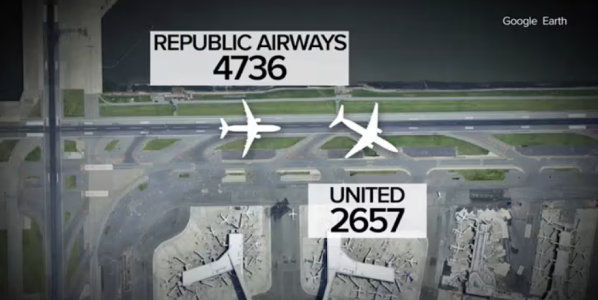Close call at LaGuardia raises concerns about air traffic safety—but here’s what passengers can do
By
Veronica E.
- Replies 0
Air travel is often praised as one of the safest ways to get from point A to point B—but a recent incident at New York’s LaGuardia Airport was a sobering reminder of how much trust passengers place in the people and systems guiding them through the skies.
In the early hours of May 6, two commercial jets—Republic Airways Flight 4736 and United Airlines Flight 2657—came within just over a quarter mile of colliding on the runway.
Thanks to quick action by an air traffic controller and the Republic pilot, disaster was narrowly avoided.
According to the Federal Aviation Administration (FAA), the near miss happened around 12:35 a.m. when a controller canceled the Republic jet’s takeoff clearance after realizing that the United plane was taxiing on the same runway.
"An air traffic controller at LaGuardia Airport in New York canceled the takeoff clearance for Republic Airways Flight 4736 because United Airlines Flight 2657 was taxiing on the same runway," the FAA confirmed in a statement provided to PEOPLE.
The United flight, which had just landed from George Bush Intercontinental Airport in Houston, was carrying 107 passengers and six crew members. The Republic flight, already accelerating for takeoff, had to come to an abrupt halt.

“As hard as any car accident”
Renee Hoffer, a passenger on the Republic jet, told the Associated Press that the sudden stop left her with a pinched nerve.
“The stop was as hard as any car accident I’ve been in,” she said.
Hoffer later went to the emergency room complaining of neck pain and a numb arm.
The FAA has stated that they had not yet received direct reports of passenger injuries but emphasized the importance of always wearing seatbelts while seated—even if the seatbelt sign is off.
LaGuardia’s systems, and what went wrong
LaGuardia is equipped with an advanced surface radar system designed to help air traffic controllers detect potential runway conflicts in real time.
But even with that technology, human error or communication gaps can still occur.
In audio obtained by ABC, a controller is heard saying, “I thought United had cleared well before that,” followed by: “Just stay there for the moment, and I got to get the other United off the way.”
The FAA and the National Transportation Safety Board (NTSB) have launched investigations.
All parties involved—Republic Airways, United Airlines, and the Port Authority—have referred questions to the FAA.
Also read: Airline CEO reveals why you should think twice before flying into this popular US airport
A pattern of recent close calls
This isn’t the first time LaGuardia has made headlines for near disasters.
A Southwest Airlines plane reportedly came within just 67 feet of the control tower during a landing in severe weather conditions.
And at nearby Newark Liberty International Airport, a 90-second blackout left air traffic controllers temporarily unable to see or communicate with aircraft.
That incident prompted the National Air Traffic Controllers Association (NATCA) to release a statement explaining that the radar and communication blackout affected controllers responsible for Newark’s airspace.
“Controllers did not ‘walk off the job,’” NATCA clarified, explaining that affected staff took absence under the Federal Employees Compensation Act due to the traumatic nature of the event.
Staffing concerns are also being cited more broadly.
In a recent move, United Airlines cut 35 daily flights into Newark, with the CEO citing “FAA staffing issues” as a reason for the adjustment, saying the decision was made to “protect” customers.
Also read: Elon Musk’s next big move in aviation–What it means for the future of air travel
What passengers can do
While travelers can’t control what happens in the control tower, they can still take small steps to stay safe and prepared during flights.
At The GrayVine, we believe travel should be empowering, not intimidating.
We’ll continue to keep you informed about aviation safety, airline policy changes, and the evolving systems that work every day to protect us in the skies.
Read next: Lawmakers propose $15B for air travel upgrades—some drivers could face new annual fees

Have you ever experienced a sudden stop or close call while flying? Do you have tips for staying calm or safe in the skies? Share your stories in the comments below—your experience may help reassure another traveler!
In the early hours of May 6, two commercial jets—Republic Airways Flight 4736 and United Airlines Flight 2657—came within just over a quarter mile of colliding on the runway.
Thanks to quick action by an air traffic controller and the Republic pilot, disaster was narrowly avoided.
According to the Federal Aviation Administration (FAA), the near miss happened around 12:35 a.m. when a controller canceled the Republic jet’s takeoff clearance after realizing that the United plane was taxiing on the same runway.
"An air traffic controller at LaGuardia Airport in New York canceled the takeoff clearance for Republic Airways Flight 4736 because United Airlines Flight 2657 was taxiing on the same runway," the FAA confirmed in a statement provided to PEOPLE.
The United flight, which had just landed from George Bush Intercontinental Airport in Houston, was carrying 107 passengers and six crew members. The Republic flight, already accelerating for takeoff, had to come to an abrupt halt.

A United Airlines plane at LaGuardia Airport, where a Republic Airways jet had to make a sudden stop to avoid a collision on the runway. Image Source: YouTube /
Eyewitness News ABC7NY.
Eyewitness News ABC7NY.
“As hard as any car accident”
Renee Hoffer, a passenger on the Republic jet, told the Associated Press that the sudden stop left her with a pinched nerve.
“The stop was as hard as any car accident I’ve been in,” she said.
Hoffer later went to the emergency room complaining of neck pain and a numb arm.
The FAA has stated that they had not yet received direct reports of passenger injuries but emphasized the importance of always wearing seatbelts while seated—even if the seatbelt sign is off.
LaGuardia’s systems, and what went wrong
LaGuardia is equipped with an advanced surface radar system designed to help air traffic controllers detect potential runway conflicts in real time.
But even with that technology, human error or communication gaps can still occur.
In audio obtained by ABC, a controller is heard saying, “I thought United had cleared well before that,” followed by: “Just stay there for the moment, and I got to get the other United off the way.”
The FAA and the National Transportation Safety Board (NTSB) have launched investigations.
All parties involved—Republic Airways, United Airlines, and the Port Authority—have referred questions to the FAA.
Also read: Airline CEO reveals why you should think twice before flying into this popular US airport
A pattern of recent close calls
This isn’t the first time LaGuardia has made headlines for near disasters.
A Southwest Airlines plane reportedly came within just 67 feet of the control tower during a landing in severe weather conditions.
And at nearby Newark Liberty International Airport, a 90-second blackout left air traffic controllers temporarily unable to see or communicate with aircraft.
That incident prompted the National Air Traffic Controllers Association (NATCA) to release a statement explaining that the radar and communication blackout affected controllers responsible for Newark’s airspace.
“Controllers did not ‘walk off the job,’” NATCA clarified, explaining that affected staff took absence under the Federal Employees Compensation Act due to the traumatic nature of the event.
Staffing concerns are also being cited more broadly.
In a recent move, United Airlines cut 35 daily flights into Newark, with the CEO citing “FAA staffing issues” as a reason for the adjustment, saying the decision was made to “protect” customers.
Also read: Elon Musk’s next big move in aviation–What it means for the future of air travel
What passengers can do
While travelers can’t control what happens in the control tower, they can still take small steps to stay safe and prepared during flights.
- Always keep your seatbelt fastened while seated
- Pay attention to safety briefings—even if you’re a frequent flyer
- Follow all crew instructions during turbulence or emergencies
- Don’t hesitate to report anything unusual to flight staff
At The GrayVine, we believe travel should be empowering, not intimidating.
We’ll continue to keep you informed about aviation safety, airline policy changes, and the evolving systems that work every day to protect us in the skies.
Read next: Lawmakers propose $15B for air travel upgrades—some drivers could face new annual fees
Key Takeaways
- A Republic Airways jet had to suddenly stop on the runway at LaGuardia Airport around 12:35 a.m. on May 6 after a United Airlines plane was found taxiing in the same space.
- The FAA said the planes were just over a quarter mile apart when the Republic pilot hit the brakes.
- Republic passenger Renee Hoffer reported a pinched nerve after the sudden stop and described it as being "as hard as any car accident" she’d experienced.
- The FAA and NTSB are both investigating the incident, despite LaGuardia having advanced radar designed to prevent runway conflicts.
- Recent incidents, including a close call involving a Southwest plane and a blackout at Newark Airport, are raising broader concerns about staffing and technology issues in air traffic control.
Have you ever experienced a sudden stop or close call while flying? Do you have tips for staying calm or safe in the skies? Share your stories in the comments below—your experience may help reassure another traveler!






